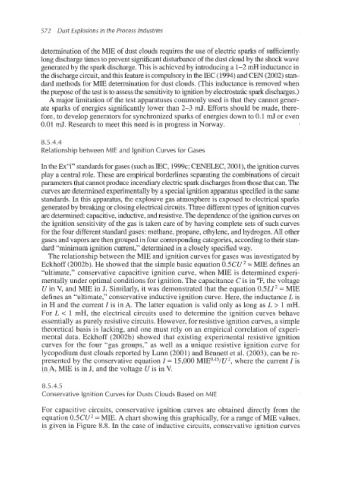Page 605 - Dust Explosions in the Process Industries
P. 605
572 Dust Explosions in the Process Industries
determination of the MIE of dust clouds requires the use of electric sparks of sufficiently
long dischargetimes to prevent significantdisturbanceof the dust cloud by the shock wave
generatedby the spark discharge.This is achievedby introducinga 1-2 mHinductance in
the discharge circuit,and this featureis compulsoryin the IEC (1994) and CEN (2002) stan-
dard methods for MIE determination for dust clouds. (This inductance is removed when
the purpose of the test is to assessthe sensitivityto ignitionby electrostaticsparkdischarges.)
A major limitation of the test apparatuses commonly used is that they cannot gener-
ate sparks of energies significantly lower than 2-3 mJ. Efforts should be made, there-
fore, to develop generators for synchronizedsparks of energies down to 0.1 mJ or even
0.01 mJ. Research to meet this need is in progress in Norway.
8.5.4.4
Relationship between MIE and Ignition Curves for Gases
In the Ex“?, standards for gases (such as IEC, 1999c;CENELEC,200l), the ignitioncurves
play a central role. These are empirical borderlines separating the combinationsof circuit
parameters that cannot produce incendiaryelectric sparkdischargesfrom those that can.The
curves are determinedexperimentallyby a specialignition apparatus specified in the same
standards. In this apparatus, the explosive gas atmosphere is exposed to electrical sparks
generatedby breaking or closing electricalcircuits.Three different types of ignition curves
are determined:capacitive,inductive,and resistive.The dependenceof the ignition curves on
the ignition sensitivity of the gas is taken care of by having complete sets of such curves
for the four different standard gases: methane, propane, ethylene, and hydrogen.All other
gases and vapors are then grouped in four correspondingcategories,according to their stan-
dard “minimum ignition current,” determined in a closely specified way.
The relationship between the MIE and ignition curves for gases was investigated by
Eckhoff (2002b). He showed that the simple basic equation 0.5CU = MIE defines an
“ultimate,” conservative capacitive ignition curve, when MIE is determined experi-
mentally under optimal conditions for ignition. The capacitance C is in “F,the voltage
U in V, and MIE in J. Similarly, it was demonstrated that the equation 0.5L12= MIE
defines an “ultimate,” conservative inductive ignition curve. Here, the inductance L is
in H and the current I is in A. The latter equation is valid only as long as L > 1 mH.
For L < 1 mH, the electrical circuits used to determine the ignition curves behave
essentially as purely resistive circuits. However, for resistive ignition curves, a simple
theoretical basis is lacking, and one must rely on an empirical correlation of experi-
mental data. Eckhoff (2002b) showed that existing experimental resistive ignition
curves for the four “gas groups,” as well as a unique resistive ignition curve for
lycopodium dust clouds reported by Lunn (2001) and Bennett et al. (2003), can be re-
presented by the conservative equation I = 15,000 MIE0.45/U2,where the current I is
in A, MIE is in J, and the voltage U is in V.
8.5.4.5
Conservative Ignition Curves for Dusts Clouds Based on MIE
For capacitive circuits, conservative ignition curves are obtained directly from the
equation 0.5C7J2= MIE. A chart showing this graphically, for a range of MIE values,
is given in Figure 8.8. In the case of inductive circuits, conservative ignition curves

